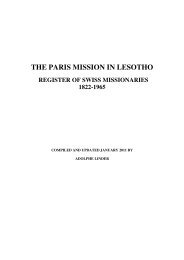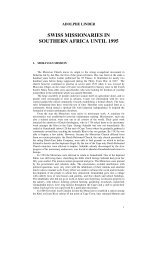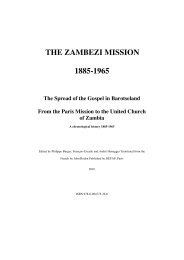THE SWISS IN SOUTHERN AFRICA 1652-1970 - swissroots-za.ch
THE SWISS IN SOUTHERN AFRICA 1652-1970 - swissroots-za.ch
THE SWISS IN SOUTHERN AFRICA 1652-1970 - swissroots-za.ch
You also want an ePaper? Increase the reach of your titles
YUMPU automatically turns print PDFs into web optimized ePapers that Google loves.
4. SHORT HISTORY OF ARRIVALS DUR<strong>IN</strong>G COMPANY RULE <strong>1652</strong>-1795<br />
4.1 Establishment of the settlement at the Cape<br />
The Portuguese pioneered the sea route to the East Indian spice islands in 1498. They<br />
established their supremacy there and gained the monopoly in the spice trade whi<strong>ch</strong><br />
they defended successfully for a hundred years. By then the steady drain of manpower<br />
had exhausted the little country and the Dut<strong>ch</strong> and English could oust them. In both<br />
these countries the mer<strong>ch</strong>ants joined together to form commercial companies with royal<br />
<strong>ch</strong>arters whi<strong>ch</strong> empowered them to conquer and rule territories. The Dut<strong>ch</strong> East India<br />
Company (Vereenigde Oostindies<strong>ch</strong>e Compagnie, abbreviated VOC), constituted by the<br />
Chambers of Commerce (Kamers) of Amsterdam (abbreviated KA). Edam (KE),<br />
Leerdam (KL), Rotterdam (KR) and Zeeland (KZ), gained predominance in Ceylon<br />
(present day Sri Lanka) and the East, with head-quarters at Batavia (present day Jakarta)<br />
and factories as far away as Formosa (present day Taiwan). Generally fleets set out<br />
twice a year when the tradewinds were favourable. If everything went well, they<br />
completed the return trip in 18 months.<br />
Long periods at sea in cramped quarters and with stale food, were the cause of scurvy<br />
and other sicknesses amongst the sailors and soldiers on the ships. This was to some<br />
extent counteracted by making landfalls en route to take in fresh water and food. It was<br />
the report of the crew of the Dut<strong>ch</strong> East-India ship Haarlem, that finally persuaded the<br />
VOC to establish a half way station there, where the crews could recuperate, fresh<br />
produce might be obtained, and the ships repaired. Junior Mer<strong>ch</strong>ant, later Commander,<br />
Jan Van Riebeeck, was sent out with three small ships and 50 men. Van Riebeeck set<br />
foot on the shore of Table Bay on 8 April <strong>1652</strong> and in the same year the order went out<br />
that henceforth all Company ships were to call there, on penalty of officers losing their<br />
bounty.<br />
On average the ships would stay 26 days at the Cape. During this time the men could<br />
recover their strength, do maintenance work on the ship and take fresh provisions on<br />
board. Initially the Cape was not a popular station. While in port the men were<br />
commandeered off the ships to help with the building of the fort, the little settlement<br />
offered no entertainment and food supplies were at times inadequate. Van Riebeeck’s<br />
men struggled to adapt their agricultural practices to local climatic conditions whi<strong>ch</strong> at<br />
that time were exceptionally wet and cold. For meat supplies they relied on the sporadic<br />
bartering of beasts from local inhabitants, the nomadic Khoi. At one time food supplies<br />
were so short that the little garrison had to be fed on penguin eggs gathered on Robben<br />
Island. However, within a few years the halfway house was well established and<br />
thenceforth fulfilled its colonial role admirably.<br />
4.2 The Voyage to the Cape<br />
The Dut<strong>ch</strong> sailing ships were beautiful to behold but made no concession to the comfort<br />
of those who sailed in them. Their size <strong>ch</strong>anged continuously as the design improved.<br />
The largest ones were of 140 tons standard displacement and 40 metres length. On<br />
average they carried 100 sailors and up to 300 soldiers, as the hired men were<br />
designated. These were all crowded together below deck. Fresh air and light could only<br />
enter the quarters by the few hat<strong>ch</strong>es and gun ports, whi<strong>ch</strong> had to be closed during<br />
stormy and wet weather. The stifling atmosphere in this dark, overcrowded space was<br />
frequently aggravated by heat and smoke from the galley, not to mention the exhalation<br />
of 400 dead tired, seasick and often sopping wet men. Conditions were even worse in<br />
the tropics with the temperature below deck often becoming quite unbearable.<br />
The duration of the sea voyage from Holland to the Cape varied greatly depending on<br />
wind and weather conditions encountered, but on average remained practically<br />
un<strong>ch</strong>anged, namely<br />
in 1659 133 days, the return trip 131 days,<br />
in 1720 139 days, 114 days, and<br />
in 1790 129 days, 112 days.<br />
10







